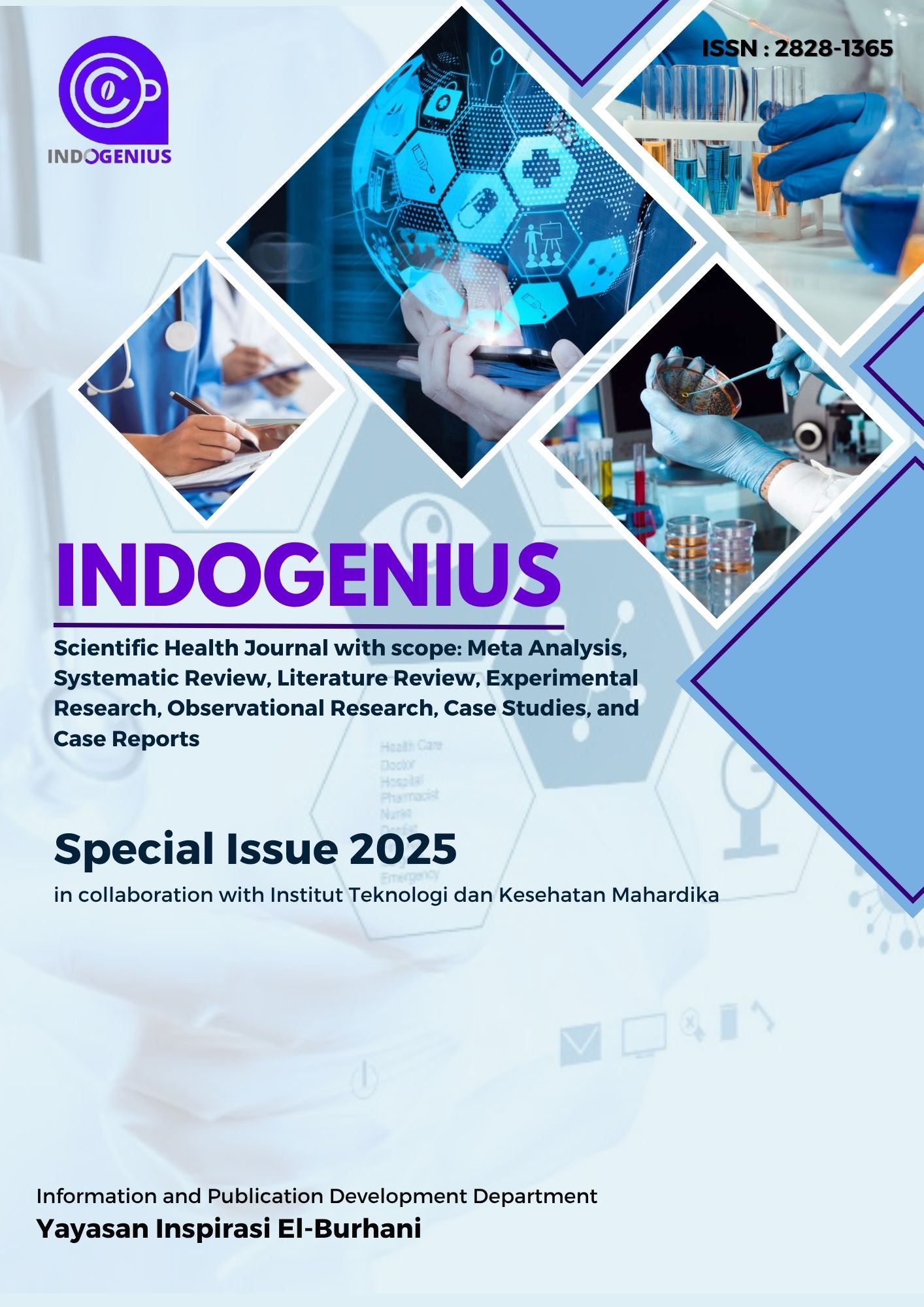Implementation of Intervention Through Range of Motion (ROM) Exercises to Overcome Physical Activity Mobility Impairment in Mrs. R in the Stroke Unit of RSD Gunung Jati, Cirebon City
DOI:
https://doi.org/10.56359/igj.v4i2A.693Keywords:
Intervention, Stroke, ROMAbstract
Background & Objective: Non-hemorrhagic stroke is a stroke that occurs due to a blockage in the blood vessels caused by a disruption in the blood supply to the brain, resulting in the cessation of blood flow to the brain. Stroke can cause disability in one of the limbs and weakness in one of the limbs. This results in the loss of coordination and the loss of balance. Therefore, therapy is needed to improve muscle strength in stroke patients through Range of Motion interventions. This final scientific work aims to analyze nursing care for patients with physical mobility disorders. Method: The research method used is a case study. The subject in this case involves one respondent with a non-hemorrhagic stroke and physical mobility disorders who is undergoing treatment in the stroke unit at RSD Gunung Jati. Data collection was conducted using interview, observation, and documentation techniques. Result: The nursing diagnoses identified for Mrs. R included physical mobility impairment, anxiety, and acute pain. The interventions provided were based on the Indonesian Nursing Diagnosis and Intervention Standards (SDKI and SIKI) and the principles of Evidence-Based Nursing (EBN). The implementation of interventions such as mobility support, although not yet fully optimal within 3 days. Range of Motion (ROM) exercises were found to have a positive impact on improving muscle strength and joint flexibility in patients, as well as reducing stiffness and pain symptoms. Conclusion: It is recommended to implement nursing care for stroke patients by applying Evidence-Based Nursing (EBN), specifically: Range of Motion.
Downloads
References
Anderson, K., & McKenzie, L. (2023). Proprioceptive deficits following stroke: Impact on mobility and rehabilitation outcomes. Journal of Stroke Rehabilitation, 15(2), 178-192.
Bella, C., Inayati, Anik et al. (2021). Penerapan Range Of Motion (ROM) Pasif Untuk Mengatasi Masalah Keperawatan Hambatan Mobilitas Fisik Pada Pasien Stroke Non Hemoragik Di Kota Metro. [Online]. Vol 1 (1). [20 Mei 2025].
Dewan Pengurus Pusat PPNI. (2018). Standar Intervensi Keperawatan Indonesia (SIKI). Jakarta: PPNI.
Doenges, M. E., Moorhouse, M. F., & Murr, A. C. (2016). Rencana Asuhan Keperawatan. Jakarta: EGC.
Davies, P. M. (2020). Steps to follow: The comprehensive treatment of patients with hemiplegia (3rd ed.). Springer.
Felinda, Cheni et al. (2021). Asuhan Keperawatan Hambatan Mobilitas Fisik Pada Tn. A Dengan Stroke Non Hemoragik Di RSUD Dr. R. Geoteng Taroenadibrata Purbalingga. [Online]. [20 Mei 2025].
Febriyanti, F., & Wulaningrum, D. (2024). Penerapan ROM Pasif Terhadap Peningkatan Kekuatan Otot Pada Pasien Stroke Non Hemoragik (SNH). [Online]. [20 Mei 2025].
Garcia-Rudolph, A., Sanchez-Pinsach, D., Salleras, E. O., & Tormos, J. M. (2021). Stroke Motor Recovery Mechanisms And Neuroplasticity Determinants: New Perspectives For Therapeutic Intervention. Neuropsychiatric Disease and Treatment, 17, 2313-2330.
Harvey, L. A., Katalinic, O. M., Herbert, R. D., Moseley, A. M., Lannin, N. A., & Schurr, K. (2020). Stretch for the treatment and prevention of contractures: An updated systematic review. Physical Therapy, 100(1), 128-145.
Kasiati dan Roslawati. (2021) “Penerapan Range Of Motion (Rom) Pada Asuhan Keperawatan Gangguan Mobilitas Fisik Pasien Stroke Hemoragik
Katz-Leurer, M., Fisher, I., Neeb, M., Schwartz, I., & Carmeli, E. (2021). Reliability and validity of the modified functional reach test at the subacute stage post-stroke. Disability and Rehabilitation, 43(10), 1436-1442.
Kumar, S., Selim, M. H., & Caplan, L. R. (2019). Medical complications after stroke. The Lancet Neurology, 18(5), 517-525.
Li, S., Luo, Y., Liu, Y., & Zhang, L. (2020). Effects of early rehabilitation on the recovery of stroke patients: A systematic review and meta-analysis. Journal of Stroke and Cerebrovascular Diseases, 29(3), 104512. https://doi.org/10.1016/j.jstrokecerebrovasdis.2020.104512
Langhorne, P., Bernhardt, J., & Kwakkel, G. (2023). Stroke rehabilitation: Recent advances and future therapies. The Lancet, 401(10377), 726-737.
Lewis, S. L., Bucher, L., Heitkemper, M. M., & Harding, M. M. (2020). Medical-surgical nursing: Assessment and management of clinical problems (11th ed.). Elsevier.
Mardiyanti, Cicillia et al. (2020). Pengaruh Penerapan ROM Pada Ekstremitas Kekuatan Oto Pasien Stroke Non Hemoragik Di Rs. Panti Nirmala. [Online]. [20 Mei 2025].
Marisa, D. E., & Purbasari, D. (2020). MOTIVASI PELAKSANAAN LATIHAN ROM PADA PASIEN STROKE BERDASARKAN DUKUNGAN KELUARGA DI PUSKESMAS CILEDUG KABUPATEN CIREBON. Jurnal Kesehatan Indra Husada Vol, 8(1).
Mayo, N. E., Bronstein, D., & Scott, S. C. (2022). Impact of stroke on quality of life: Long-term follow-up study. Stroke, 53(5), 1788-1796.
McCance, K. L., & Huether, S. E. (2022). Pathophysiology: The biologic basis for disease in adults and children (9th ed.). Elsevier.
Marzolini, S., et al. (2021). The role of physical activity and exercise in post-stroke recovery. Archives of Physical Medicine and Rehabilitation, 102(5), 1025–1033. https://doi.org/10.1016/j.apmr.2020.12.008
Melnyk, B. M., & Fineout-Overholt, E. (2018). Evidence-Based Practice in Nursing & Healthcare: A Guide to Best Practice (4th ed.). Wolters Kluwer.
Kusumawaty, J., & Nurapandi, A. (2022). Edukasi Dan Mobilisasi (ROM) pada Lansia Penderita Stroke dengan Audio Visual di Panti Jompo Welas Asih Tasikmalaya. Kolaborasi: Jurnal Pengabdian Masyarakat, 2(1), 45-51.
NANDA International. (2021). Nursing diagnoses: Definitions and classification 2021-2023 (12th ed.). Thieme.
Nakayama, H., Sato, K., & Ueda, R. (2024). Long-term mortality and predictors of survival in patients with mobility impairments after stroke. International Journal of Stroke, 19(2), 128-135.
Oliveira, C. B., Medeiros, Í. R., Frota, N. A., Greters, M. E., & Conforto, A. B. (2018). Balance control in hemiparetic stroke patients: Main tools for evaluation. Journal of Rehabilitation Research and Development, 55(8), 1055-1066.
Permatasari, Indah el al. (2024). Penerapan Terapi Range Of Motion Terhadap Peningkatan Kekuatan Otot Pada Pasien Dengan Stroke. [Online]. Vol 4 (2). [20 Mei 2025].
Pratama, M et al. (2020). Penerapan Rangr Of Motion (ROM) Terhadap Peningkatan Kekuatan Otot Pada Pasien Dengan Stroke. [Online]. [20 Mei 2025].
Persatuan Perawat Nasional Indonesia (PPNI). (2019). Standar Diagnosis Keperawatan Indonesia: Definisi dan Indikator Diagnostik (Edisi 1/Revisi). PPNI.
Park, J., & Kim, Y. (2024). Effects of early passive and active-assistive range of motion exercises on functional outcomes in acute stroke patients: A randomized controlled trial. Archives of Physical Medicine and Rehabilitation, 105(3), 452-461.
Potter, P. A., & Perry, A. G. (2015). Fundamentals of Nursing (9th ed.). St. Louis: Elsevier.
Papa, Alfred. (2023). Penerapan Intervensi Rom (Range Of Motion) Dalam Meningkatkan Mobilitas Fisik Pada Pasien Dengan Snh (Stroke Non Hemorragic) Di Puskesmas Oepoi. [Online]. [20 Mei 2025].
Rahman, M. H., Sadat, M. N., & Khan, M. A. A. (2023). Biomechanical alterations in stroke patients: Implications for rehabilitation and mobility training. Journal of Biomechanics, 146, 111523.
Rodrigues-Baroni, J. M., Nascimento, L. R., Ada, L., & Teixeira-Salmela, L. F. (2021). Functional mobility correlates with quality of life and depression in individuals with chronic stroke. Physical Therapy, 101(4), pzab022.
Seryawati, Vera., & Retnaningsih, D. (2024). Penerapan Range Of Motion Pada Pasien Stroke Non Hemoragik Dengan Gangguan Mobilitas Fisik. [Online]. Vol 8 (1). [20 Mei 2025].
Satyanegara. (2018). Ilmu Bedah Saraf (5th ed.). Gramedia Pustaka Utama.
Smeltzer, S. C., & Bare, B. G. (2020). Brunner & Suddarth's textbook of medical-surgical nursing (15th ed.). Wolters Kluwer.
Suratun. (2020) Penerapan Rom Pasif Terhadap Peningkatan Kekuatan Otot Pasien Dengan Stroke Non Hemoragik.” Jurnal Cendekia Muda 2(4):443–46.
Ratnawati. (2021). Keperawatan Medikal Bedah 2. Yogyakarta.
Tiyas, Y., & Rakhmawati, N. (2024). Penerapan Rame Of Motion (ROM) Terhadap Peningkatan Kekuatan Otot Pasien Stroke Non Hemoragik Dengan Gangguan Mobilitas Fisik Di Rumah Sakit Pku Aisyiyah Boyolali. [Online]. [20 Mei 2025].
Thrift, A. G., Cadilhac, D. A., & Donnan, G. A. (2023). The concept of diaschisis in acute stroke recovery: New perspectives from neuroimaging. Nature Reviews Neurology, 19(5), 269-28.
Veerbeek, J. M., van Wegen, E. E., van Peppen, R. P., Hendriks, H. J., Rietberg, M. B., & Kwakkel, G. (2022). What is the evidence for physical therapy poststroke? A systematic review and meta-analysis. PLoS One, 17(2), e0265019.
Wei, X., Zhao, Y., Zheng, X., Chen, L., & Wu, Q. (2023). Comparative effectiveness of different rehabilitation interventions for mobility recovery after stroke: A network meta-analysis. Frontiers in Neurology, 14, 1123456.
Winstein, C. J., Stein, J., Arena, R., Bates, B., Cherney, L. R., Cramer, S. C., & Zorowitz, R. D. (2022). Guidelines for adult stroke rehabilitation and recovery: A guideline for healthcare professionals from the American Heart Association/American Stroke Association. Stroke, 53(7), e558-e617.
Zhang, L., Zeng, Y., Qi, S., Yin, H., & Chen, Y. (2022). The effect of early nursing intervention on the rehabilitation of neurological function and the quality of life in patients with stroke. American Journal of Translational Research, 14(3), 1990-2000.
Downloads
Published
How to Cite
Issue
Section
License
Copyright (c) 2025 Safira Melenia Amal, Citra Setyo Dwi, Andini , Dwiyanti Purbasari

This work is licensed under a Creative Commons Attribution 4.0 International License.

















